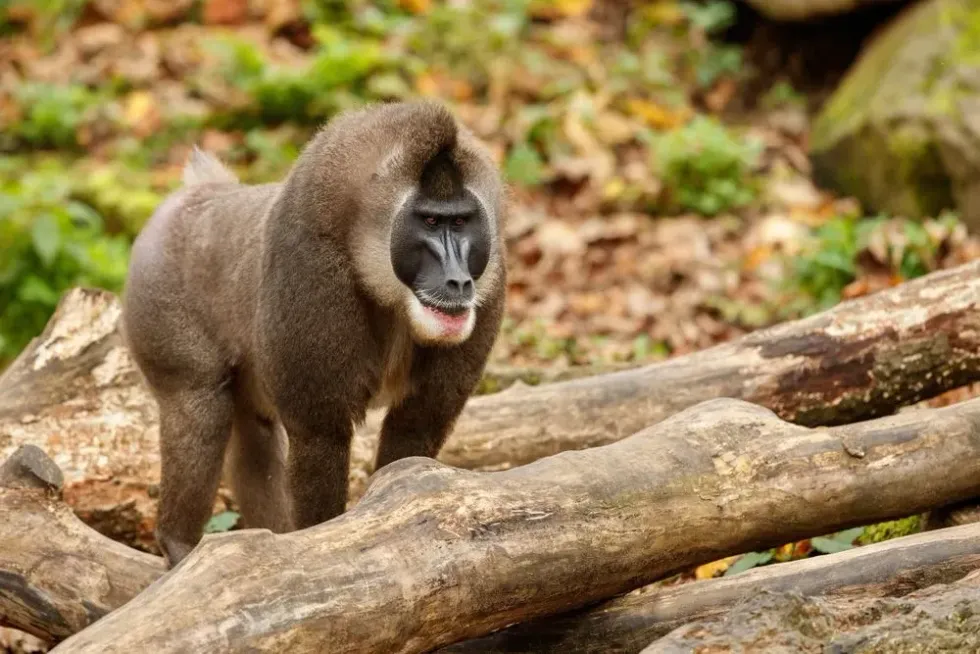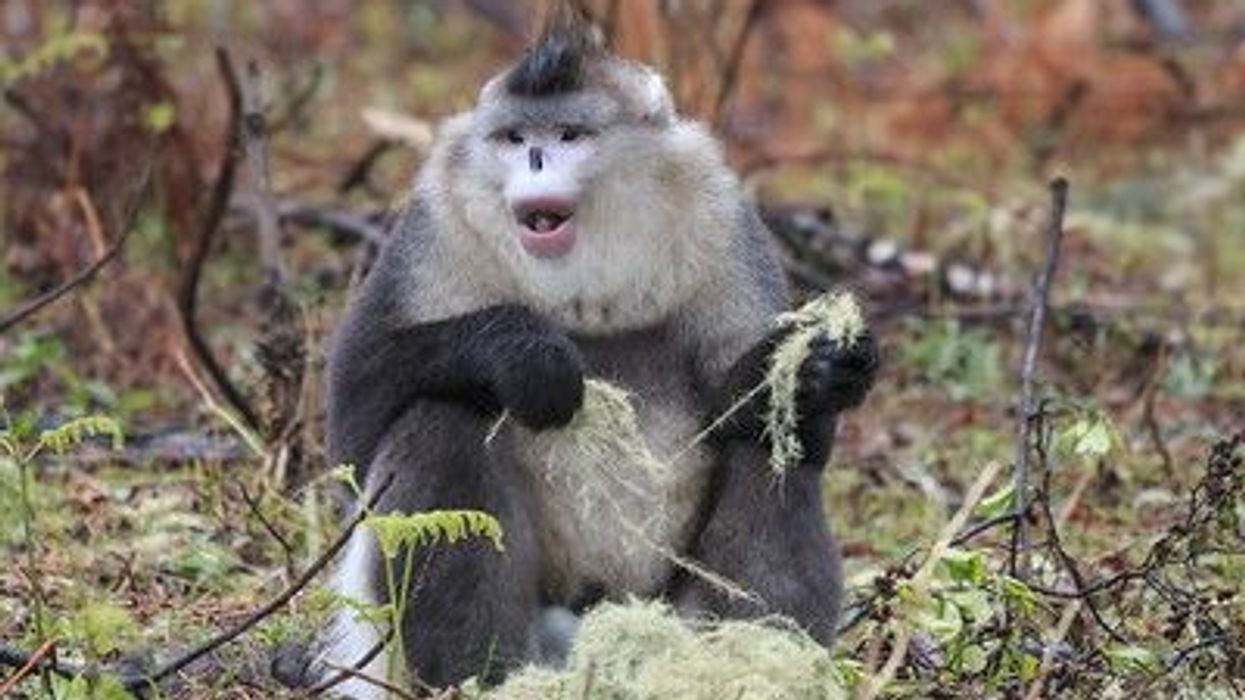Drill monkeys (Mandrillus leucophaeus) are Old World monkeys in the same family of primates as baboons, and langurs. These short tailed primates are cousins of the fun colorful mandrill and are one of the largest monkeys in the world.
Their range is very small in dense forests of Western Africa, north of the Sanaga river in Cameroon and Nigeria. They also live on Bioko Island in Equatorial Guinea.
The largest concentration of their population is in Korup National Park in Cameroon. The preferred drill habitat is dense forest on the coast or close to a river.
The drill monkey is active during the day and rests at night. Male drills have a beautiful wide grin, shiny black face, bright red lower lip, and colorful rumps that range in shades of red and blue.
They use these colorful rumps as means of communication during breeding season. Drill diet consists of primarily fruits and leaves. They live in social groups of up to 25 monkeys with a dominant male.
During breeding season, male drills rub their chests on trees to mark their territory! The conservation status of this species of primates is Endangered because of hunting and destruction of habitat.
Like this article? Learn about other species of primates like howler monkey and Diana monkey.
Drill Monkey Interesting Facts
What type of animal are drill monkeys?
Drill monkey (Mandrillus leucophaeus) is a species of primates same as baboons. Their cousin is the colorful mandrill.
What class of animal do drill monkeys belong to?
Drill monkeys (Mandrillus leucophaeus) belong to the class of mammals. They are primates who belong to the family of Old World monkeys (Cercopithecidae).
How many drill monkeys are there in the world?
Due to habitat destruction and extensive hunting of these monkeys, there are thought to be as few as 3,000 drills in the wild, mostly in Africa. Most dense population of these primates is in Korup National Park in Cameroon.
Only few are in captivity in zoos. Rest of the population is divided in forests north of the Sanaga river in Nigeria and Bioko Island.
Where do drill monkeys live?
Drill monkeys (Mandrillus leucophaeus) live in the wild in mature dense forests. The range of these primates is limited to an area of 40,000 sq km in Western Africa. They are found north of the Sanaga river in Cameroon and Nigeria, and Bioko Island in Equatorial Guinea.
What is a drill monkey's habitat?
Drills live in dense lowland coastal forest on Bioko Island, and riverine forest of the Sanaga river. Forest habitats in Cameroon and Nigeria are perfect for their sustenance.
They forage for food on the forest floor during the day and retreat to the canopy of trees at night to sleep. When faced with a predator, drills climb high up into the trees to escape. Although they prefer mature dense forest, they also range in secondary younger forest in their geographical range.
Who do drill monkeys live with?
This species of primates is very social. They live in groups of 20-25 monkeys with multiple males and females with their offspring and a dominant male.
When young males become mature, they separate from their groups and go off to live on their own. Within the groups, drills do a lot of grooming. This activity is important for creating and maintaining social bonds in the groups.
How long do drill monkeys live?
On average, drills in the wild live for 28 years. The record for longest living drill monkey is 46 years! Female drills tend to live longer than the males.
How do they reproduce?
Not much is known about the mating habits of drills because they are shy and not many remain in the wild. It is believed the dominant male has multiple females. Breeding season is from December to April.
When aroused, the rumps of both males and females turn bright red. Females give birth to a single baby. The gestation period is five to six months.
What is their conservation status?
The conservation status of drill monkeys (Mandrillus leucophaeus) is Endangered (EN). These Old World monkeys are extensively hunted for their meat.
The range of drill habitat is very small to begin with. Widespread logging and farming activities have resulted in massive destruction of said habitat. Population of drills is very low, making them the most endangered primate species in Africa.
Drill Monkey Fun Facts
What do drill monkeys look like?
Drills (Mandrillus leucophaeus), one of the largest monkeys in the world, have olive brown fur tinged with yellow. Male drills have a bright red lower lip and are up to three times bigger than females.
Talking about drill monkey vs mandrill, their face is not as colorful as their fun looking cousin’s. Instead, they have a shiny black face.
The most colorful part of the male drills is their buttocks. It has hues of red, pink, and blue. This is due to a concentration of blood vessels in the area.
The buttocks of females and young drills is not as colorful as male drills. This species of Old World monkeys have short tails which are only 28 in (71 cm) long.
How cute are they?
Drills are not as cute as some other species of monkeys. But that doesn't mean they are not impressive! Baby drills are adorable.
How do they communicate?
Communication between drills is mostly visual. They present their buttocks either as a sign of submission or as asking to be groomed.
The display of drill monkey teeth, unlike other primates, is a friendly sign and not threatening. Drills use very loud screeches and calls while foraging for food in the forest for group communication. Male drills secrete a scented liquid during breeding season and rub their chests on the trees to mark their territories.
Another important social activity is grooming. Female drills groom their young ones and other males to increase bonding.
How big are drill monkeys?
Drills are 2-2.5 ft (609.6-762 mm) in length. They have a short tail which is 28 in (71 cm) long. Even though they are one of the world's largest monkeys, drills are less than half the size of an average human.
How fast can drill monkeys run?
Since drill monkeys are so shy, they are very hard to observe in the wild. For this reason, it has not been established how fast they can run.
How much do drill monkeys weigh?
Drills (Mandrillus leucophaeus) weigh anywhere between 27.5-110 lb (12.4-49.8 kg). This is because male drills are up to three times bigger than the females! They are one of the largest monkeys!
What are the male and female names of the species?
Even though both are different in shape and size, male and female of the species do not have different names. Both are called drill monkeys.
What would you call a baby drill monkey?
Baby drills do not have any special name assigned. They are simply called the offspring or baby.
What do they eat?
The diet of drills is omnivorous. Their food of choice is fruits and forest foliage. Insects, invertebrates, eggs, and small mammals are also part of their diet, but only when fruits are hard to find.
Are they aggressive?
Aggression is only used to reinforce hierarchy within groups. During the breeding season the dominant male drill may become aggressive with other males if they approach the female of his choice. A female drill may act aggressively towards another female if she is getting noticed more by males.
Would they make a good pet?
No, they would not make a good pet. Drills are very shy and flee when they hear humans approaching in the forest. These primates do not respond well to being in captivity. It would be hard to find drills in the zoo.
Did you know...
Drill monkeys (Mandrillus leucophaeus) have cheeks with deep pouches which they use to store food. These pouches can hold as much food as their stomach!
How is a drill monkey offspring raised?
Female drills give birth to a single baby. The offspring is raised primarily by its mother. Its siblings and other young monkeys in the group may also help in rearing and doing fun activities with the baby. Like many other primates, the mother grooms the baby, cares for it, and protects it until it matures.
When did the drill monkey share a common ancestor with humans?
Humans and drill monkeys (Mandrillus leucophaeus) shared a common ancestor around 25 million years ago! All humans and monkey species that are alive today have evolved from those ancestor monkeys.
However, at a certain point in time, humans starting evolving on a separate path called apes, while drills as a species kept evolving the same way. Then around eight million years ago, humans started evolving on yet another different path from the apes and have stayed on that path since.
Here at Kidadl, we have carefully created lots of interesting family-friendly animal facts for everyone to discover! For more relatable content, check out these gorilla facts and capuchin monkey facts for kids.
You can even occupy yourself at home by coloring in one of our drill monkey coloring pages.










